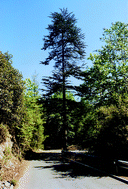Strontium isotopic and tree-ring signatures of Cedrus brevifolia in Cyprus
Abstract
This paper presents initial data from an ongoing study that employs strontium (Sr) isotopic analysis (87Sr/86Sr ratios) in an attempt to provenance archaeological cedar wood from the east Mediterranean region. Cedar was used in shipbuilding, among other roles, in ancient Egypt and the Near East, and provenance of recovered wood is only surmised in studies to date. As the first step in this dendroprovenance study, a ca. 600 year dendrochronology was developed for living cedars on Cyprus, extending back to about AD 1412. Additionally, 87Sr/86Sr ratios for wood provenance are established for two different cedar groves in the Troodos Mountains in Cyprus. The 87Sr/86Sr results reflect a closer correlation of cedar wood with seawater than with Troodos ophiolite bedrock, indicating the greater influence of sea-induced rainfall and sea-spray in this island environment. The results of the Cypriot wood are compared to Cedrus libani from Lebanon and Turkey with promising results. Due to the higher value of 87Sr/86Sr results for C. brevifolia in Cyprus, versus intermediate and lower values for Turkey and Lebanon, respectively, successful provenance of archaeological wood may be possible. In the future, this method may be coupled with dendroprovenancing techniques for more accurate localized results.

- This article is part of the themed collection: Archaeometry

 Please wait while we load your content...
Please wait while we load your content...